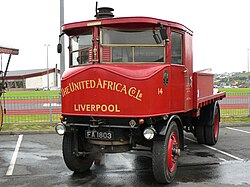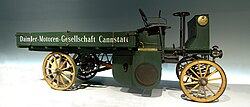Cabin (truck)

The cabin or cab of a truck is the inside space in a truck where the driver is seated. Modern long-haul (long distance) trucks cabs usually feature air conditioning, a good sound system, and ergonomic seats (often air-suspended). Pickup truck cabs have options that can make them as comfortable to drive as a car.[1]
Pickup trucks
There are usually three types of cabs in pickup trucks:
Larger trucks
There are a few possible cab configurations:
- A sleeper (or sleeper berth or bunk) is a compartment attached to the cab where the driver can rest while not driving. It is frequently on long-haul semi-trailer trucks. They can range from a simple 2 to 4 foot (0.6 to 1.2 m) bunk to a 12-foot (3.7 m) apartment-on-wheels. It allows drivers to spend weeks on the road moving cargo.[4]
- Cab over engine (COE) or flat nose, where the driver is seated on top of the front axle and the engine. They came into use just before World War II.[5] Cabovers have a shorter wheelbase and good visibility.[5] COE's are still popular among medium and light duty trucks in the United States. To access the engine, the whole cab tilts forward.
- Conventional cabs are the most common in North America and Australia. The driver is seated behind the engine as in most passenger automobiles or pickup trucks.[6] Conventionals are further divided into "large car" and "aerodynamic" designs. A "large car" or "long nose" is a conventional truck with a long (6 to 8 foot (1.8 to 2.4 m) or more) hood. With their very square shapes, these trucks experience a lot of wind resistance. They typically consume more fuel. They also provide somewhat poorer visibility than their aerodynamic or COE counterparts. By contrast, Aerodynamic cabs are very streamlined. They have a sloped hood and other features to lower drag. The front doors are behind (and mostly above) the front tires. Access to a conventional cabin is commonly by steps at or near the fuel tank(s) behind the front tires.
Cabin (truck) Media
Sentinel steam wagon
Daimler Motor-Lastwagen from 1898
1903 Eldridge truck on display at the Iowa 80 Trucking Museum, Walcott, Iowa.
Foden diesel truck from 1931
1911 Walker Electric truck on display at the Iowa 80 Trucking Museum, Walcott, Iowa.
President Joe Biden test driving the Ford F-150 Lightning all-electric pick up at Ford's Rouge Electric Vehicle Center
Mannesmann Mulag truck at the Finlayson factory in Tampere, Finland in 1921
References
| Wikimedia Commons has media related to Lua error in Module:Commons_link at line 62: attempt to index field 'wikibase' (a nil value).. |
- ↑ Craig Cheetham, American Cars of the 1990s and Today (Milwaukee, WI: Gareth Stevens Publishing, 2007), p. 17
- ↑ "Pickup Truck Cab Styles Guide". autoaccessoriesgarage.com. Retrieved 15 April 2019.
- ↑ 3.0 3.1 "Pickup Truck Cab Styles Guide". RealTruck.com. Archived from the original on 11 June 2015. Retrieved 28 May 2015.
- ↑ Chris Oxlade, Trucks Inside and Out (New York: Rosen Publishing Group's PowerKids Press, 2009), p. 24
- ↑ 5.0 5.1 Mike Byrnes and Associates, Bumper to Bumper: The Complete Guide to Tractor-trailer Operations (Corpus Christi, TX: Mike Byrnes and Associates, 2003), p. 139
- ↑ Mike Byrnes and Associates, Bumper to Bumper: The Complete Guide to Tractor-trailer Operations (Corpus Christi, TX: Mike Byrnes and Associates, 2003), p. 138











